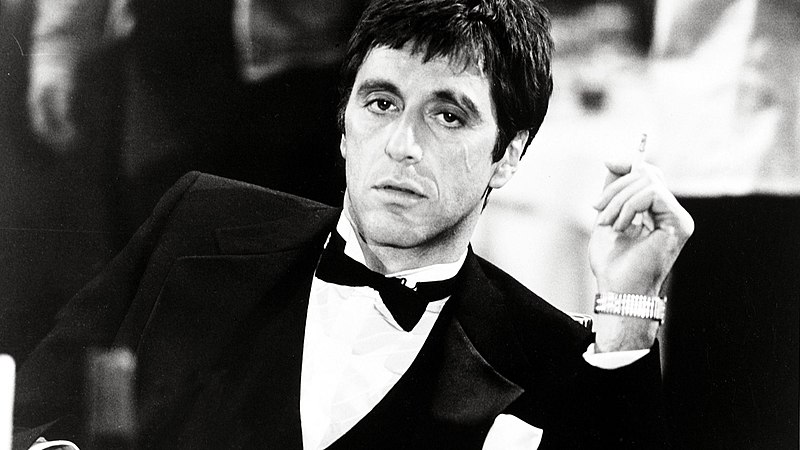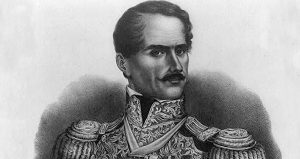There are very few men who have been able to simultaneously live in public and successfully break the law, all while consistently getting away with it. One of the most notorious people to have done this was the late mob boss Al Capone. Al Capone ran an illegal operation which, adjusted for inflation, would have been worth over a billion dollars today. Apart from being very respected and feared by his rival gang members, everyday people often gave him credit for being successful against the tremendous odds he was facing, even if they didn’t always agree with his goals.1 One of these people was the director of Scarface, Brian De Palma.

In the first opening scene of Scarface, the camera settles on a man named Tony Montana, who is undergoing questioning by Border Patrol after having just migrated from Cuba. Originally, nothing about him really made him stand out from the other Cubans save a huge scar on the left side of his face. Throughout the course of the film, that very same un-extraordinary Cuban goes from working in a soup truck and preforming low level drug deals to ruling over his city as a Kingpin and controlling all of the drug trade within the district. Likewise, Al Capone was a famous mobster, also nicknamed Scarface, who ran an illegal mob that committed crimes consisting of gambling, providing alcohol during prohibition, and selling drugs, just to name a few.2
Capone was known for his life of crime, and although the government usually kept a keen eye on him, they never managed to officially catch him in an illegal act, so he always got away scot-free. What set Capone apart from other mobsters at the time was his unusual love for the limelight. Throughout Scarface, the audience is surprised as they observe one of the most wanted men in the nation throwing the classic “millionaire mansion party,” or taking a trip to the most luxurious club in the city to party like there weren’t people doing all they could to capture him. Just like Scarface, Capone never had any fear of being spotted and actually made himself quite noticeable whenever he would go out in public. Capone would often flaunt his wealth by taking strolls through Chicago, which was struggling through the great depression, wearing dazzling and expensive suits with his signature fedora.3
It is no mere coincidence that the main character of Scarface, Tony Montana, is seen wearing similar outfits throughout the film. Capone was also never known to be alone and had security with him at all times when he took trips through the city, which is another fact reflected in the film by the use of a secondary character: a best friend/body guard that seems to be there for Tony whenever he finds himself in a predicament that’s too much for him to handle. Capone never saw himself as a criminal, but as a business man and entrepreneur because of his success during the “roaring twenties.” He enjoyed the idea of people knowing that he had money, but he was also generous with it. He helped out people who were struggling during the tough economic times whenever the opportunity was presented, and this popular generosity resulted in crowds of people flocking to him for help even if they had never previously met.4

Another signature trait of Capone that made him very different from the average mobster was his personality, and the film captured it perfectly. Capone wasn’t the typical dubious and suspicious crime boss, but rather, was seen as a friendly man with an extroverted personality and a kind smile. In Scarface, Tony Montana was a very likable person and people wanted to work with him because of that. He would also crack jokes at tense times, and knew how to have fun with any predicament he was in. In real life, Capone enjoyed being seen in a positive way by the public eye and would often speak with the press to ensure that stories and articles written about him were not doing anything but making him look good. His amiable nature was reflected within the mob community, too, and when Chicago began to show signs of chaos, he took matters into his own hands and called for a “Peace Conference” to help control the out-of-hand criminal activities that were sprouting up.5
Of course, Capone knew that his smile would only go so far, as he many times claimed, “You can get further with a gun and a smile than you can with just a smile.“6 Capone demonstrated his friendly personality until he believed that his kindness could not help him achieve his goals, in which case he would often resort to his other known behavior: that of a cold–blooded killer. This conflict of personality was a trait that Tony Montana displayed openly within the film numerous times. The screenplay is not shy at all to depict the cruel and heartless nature that Capone utilized during his time as a mob boss. He was respected for his reputation, but feared because of his bipolar personality. The boss could be friendly one second, but when his personality changed, there was no going back, and that friendly man with a smile could quickly become a ruthless killer driven only by his personal desires. There are countless scenes in Scarface where Tony Montana totally loses his temper in a split-second, just like Al Capone. This bipolar trait and the sheer unpredictability of his personality and actions were exactly what helped him rise to the top.

Although Capone was one of the richest people in America because of his successful business and his strategies to avoid prosecution, the law eventually caught up with him. During his trial, the judge was faced with a lack of evidence for any of the many crimes, murders, and illegal activities that Capone had committed, and so the judge had no choice but to send him to prison for tax evasion. Close to the end of Scarface, we see Tony Montana enjoying his life in his extremely successful business, to the point where his problem is actually that he has too much money to account for. After getting set up by some cops, Tony is caught red handed and the audience was led to believe that he was finally going to have to pay for all of his illegal activities that he had previously committed. After Capone was sent to jail for income tax evasion, his life in crime fell apart.7

Due to his overwhelming popularity, he was sent to the most secure jail that the United States could provide at the time — Alcatraz. When he was finally released from prison eleven years later, he was no longer able to continue his life of crime, and the notorious gangster “Scarface” was gone. In his place stood a man who no longer took interest in crime, but turned in his criminal duties for fishing and living in his home in peace and tranquility.8 Mirroring Capone, Tony Montana had his lawyer successfully prove him innocent of all crimes that he had done save tax evasion. Immediately following Tony Montana’s conviction, his drug empire began to fall apart. His bipolar personality began to flare up more and more, partially due to his addiction with cocaine, another thing that Capone dealt with during his lifetime and especially during his rise and fall of success. This led to the character’s dramatic death, which has gone down in cinema history as one of the best epic finales of all time. Scarface ultimately died, and there is no Al Capone to left to live in peace and tranquility.
Al Capone owes a large part of his success as one of the most notorious and successful criminals of all time to his unique personality, one that allowed him to run crime in a way no one before him had ever thought of. While his Scarface persona may have died after he was released from jail, it lived on and was represented in the film Scarface, as well as through the media continuing the legacy of the world renowned criminal.
- “The True Story Of Scarface,” Trendchaser, November 1, 2017, https://www.trend-chaser.com/history/the-true-story-of-scarface/. ↵
- “Al Capone’s tax trial and downfall,” My Al Capone Museum, January 7, 2010, http://www.myalcaponemuseum.com/id146.htm. ↵
- Ashleen Wicklow, “Mob Mondays – Five True Mob Stories Behind Scarface,” AMC, 2015, https://www.amc.com/shows/the-making-of-the-mob/talk/2015/07/mob-mondays-five-true-mob-stories-behind-scarface. ↵
- Jim Fisher, “Al Capone Was a Nice Guy?” January 1, 1970. ↵
- James P. Kirby, “Al Capone Is New York’s Contribution to Gangland,” The Times Herald, September 1928, 4. ↵
- “Real Al Capone Quotes,” My Al Capone Museum, January 7, 2010, http://www.myalcaponemuseum.com/id146.htm. ↵
- “Al Capone Biography,” Biography Online, https://www.biographyonline.net/business/al-capone-biography.html. ↵
- Paul Harrison, “Al Capone to Be Released from Philadelphia’s Eastern Penitentiary after Serving 10 Month Sentence,” The Times Herald, March 1930, 1. ↵



62 comments
Destiny Lucero
I’ve never sat to actually watch Scarface, but I do know of his famous scenes and quotes. I didn’t realize there was a real mobster similar to Scarface which makes me feel naive. This comparison between the two makes it a great and interesting read. It’s sad that Al Capone didn’t think of his self as a criminal because of his successful business and likability. If he could have applied his skills to a legal field of work maybe he could of came out on top in Forbes. However, his mental illness probably played a huge role in why he was in illegal business to begin with. To come out a changed man from Alcatraz… that must be a very terrifying, traumatizing place.
Melanie Fraire
It was interesting to read about how well known and liked he was just as if he was an ordinary citizen yet it his criminal acts were still known by others, it’s pretty crazy that he managed to get away with so much yet in the end he went down for tax evasion. I had some prior knowledge of Al Capone yet not as much as what I’ve read from this article which was a pretty good summary of his life in my opinion.
Nathan Alba
I had always heard stories about Al Capone but I like how this article resorted to using the movie as a reference to understand how Al Capone was seen in the lime light. When talking about Capone’s abrupt and sometimes unexpected personality and behavior I saw it as kind of a battle within Capone himself. On one hand he is trying to enjoy the “fruits of his labor” and be that happy-go-lucky guy, but his other personality was more of a realist and showed his true vicious nature.
Annissa Noblejas
A possible contributor to his drastic personality shift after prison was the diagnosis of syphilis, by then in its late stages. Al Capone suffered neuropsychiatric symptoms as was most likely mentally incapable of full functions. The correlation between prohibition and the rise of organized crime has always interested me. I wonder, would Al Capone have gained such wealth and influence were it not in large part due to his bootlegging business? Or would he have remained a ‘lower level’ criminal?
Ana Jimenez de la Garza
This article is extremely fascinating. Although I had a basic understanding of who Al Capone was, I never knew he was a very well known figure in the United States. Moreover, I did not know that the movie Scarface starting Al Pacino was based on the real-life Scarface. I like how the article talks about the differences and similarities both of these men had. Overall, well written article.
Juliana Montoya
Al Capone was no doubt a manipulative being because he was never caught for all of the crimes that he had committed and he was still living such a luxurious life. I found the article to be very informative about his life, especially about his bipolar disorder that I did not know he had. The life of Al Capone seemed very lavish but at some point he was bound to fall since the government was constantly watching him.
Sara Guerrero
I like the comparison between the story of Al Capone and the movie Scarface and how the coincidences between the movie and the mobster are similar to the real mobster. I didn’t know that Al Capone didn’t see himself as a criminal, but reading this article it’s like he described himself as friendly and kind business man despite being a killer. I have never seen the movie Scarface, but the way you describe and compare it to the mobster give me an overview of what the movie is about.
Peter Alva
I loved reading this article, scarface is one of my favorite movies and I like how you did somehow find a parallel between Capone and Tony Montanna. These figures both fake and real have been a huge part in pop culture, this is the life and being able to do whatever you want and when you want is what a lot of people see as the “American Dream”, Al Capone had to pay for what he did for all the evidence was against him and all the cops that he didn’t pay were out for him. His arrest was inevitable from the beginning and all it took was the one person who was dedicated to taking him down.
Luis Jaen
This article brought to my attention a lot about Al Capone that I had not previously known, although I do not know a lot about him. It was interesting to read about how he was so well liked by the public, but was so easy to flip a switch and become a “cold-blooded killer.” I never knew about his addiction to cocaine and how it ultimately came to his demise. This article shows a lot of parallels between a critically-acclaimed movie and a real life man. Overall, this article was very interesting seeing how well the author compared both the movie and Al Capone’s life.
Arsema Abera
I have never watched the movie “Scarface” or have heard about the infamous mob leader Al Capone. It was amusing to read about him in detail, about his rise and failure he seemed to be a different mobster from his contemporaries in so many ways especially in loving the limelight, knowing his wanted by the government. Although Al Capone was a taker it was good to read that he was generous and was a giver as well. It was sad to read that he ended up in the worst place and died a miserable death but Al Capone will always be remembered as the man that lived without fear or resentment in his life.